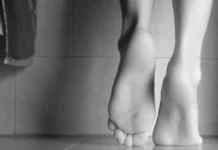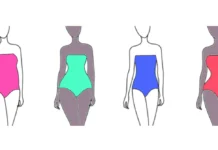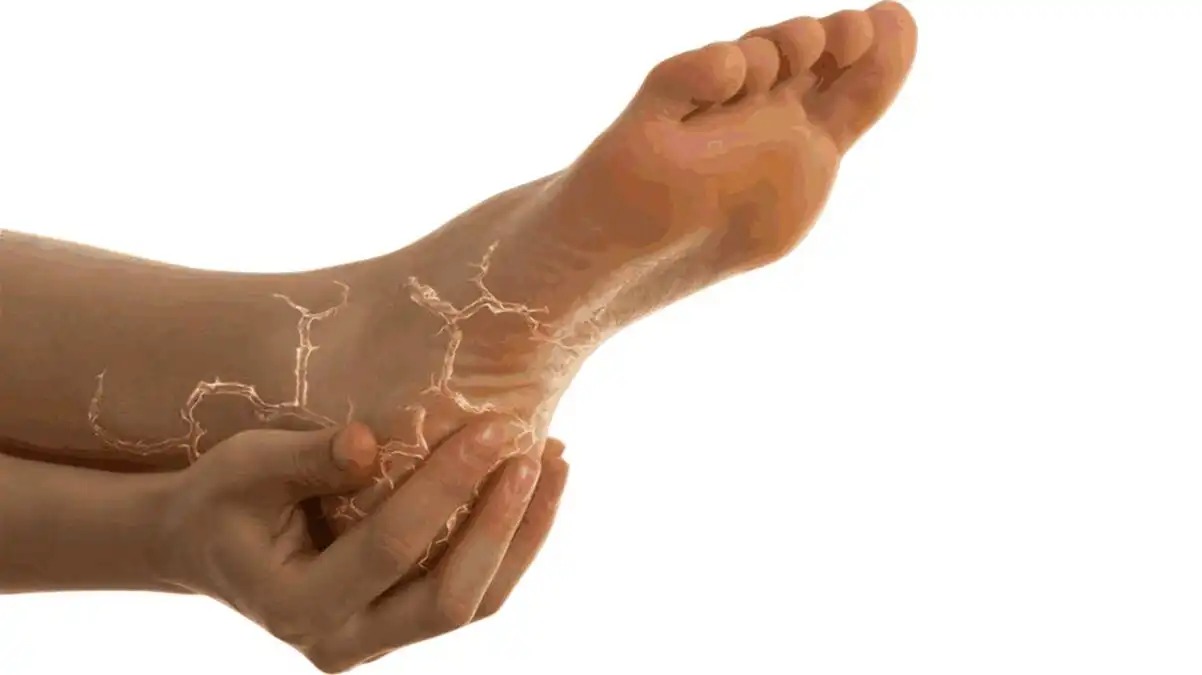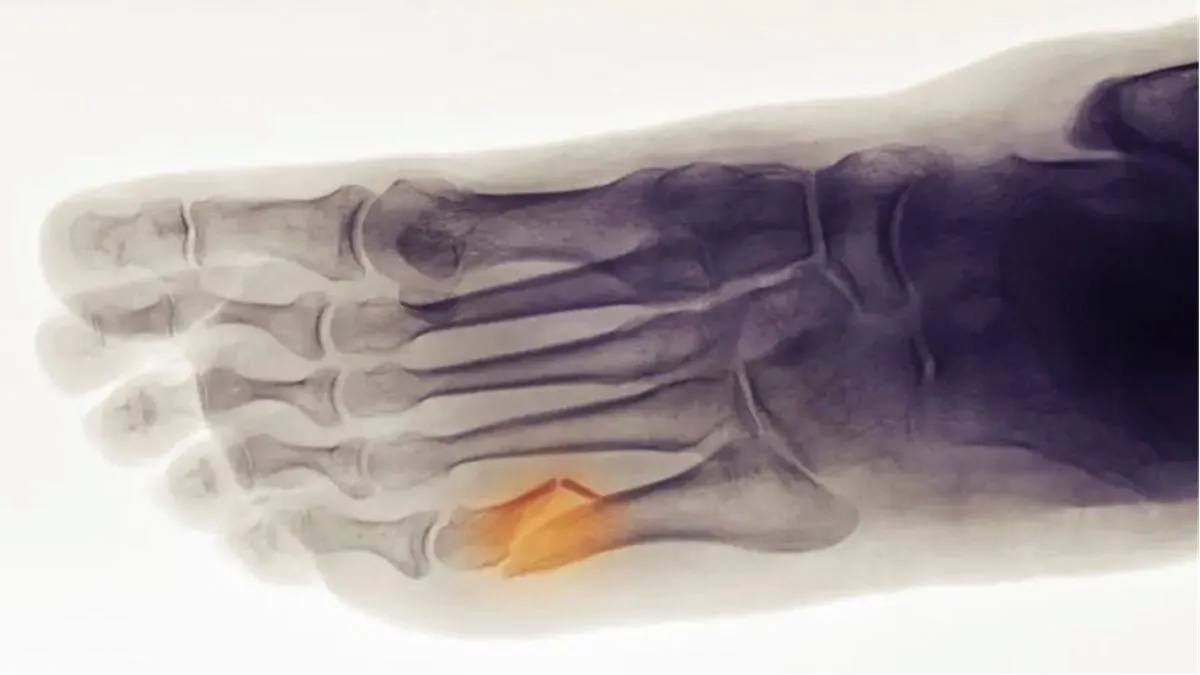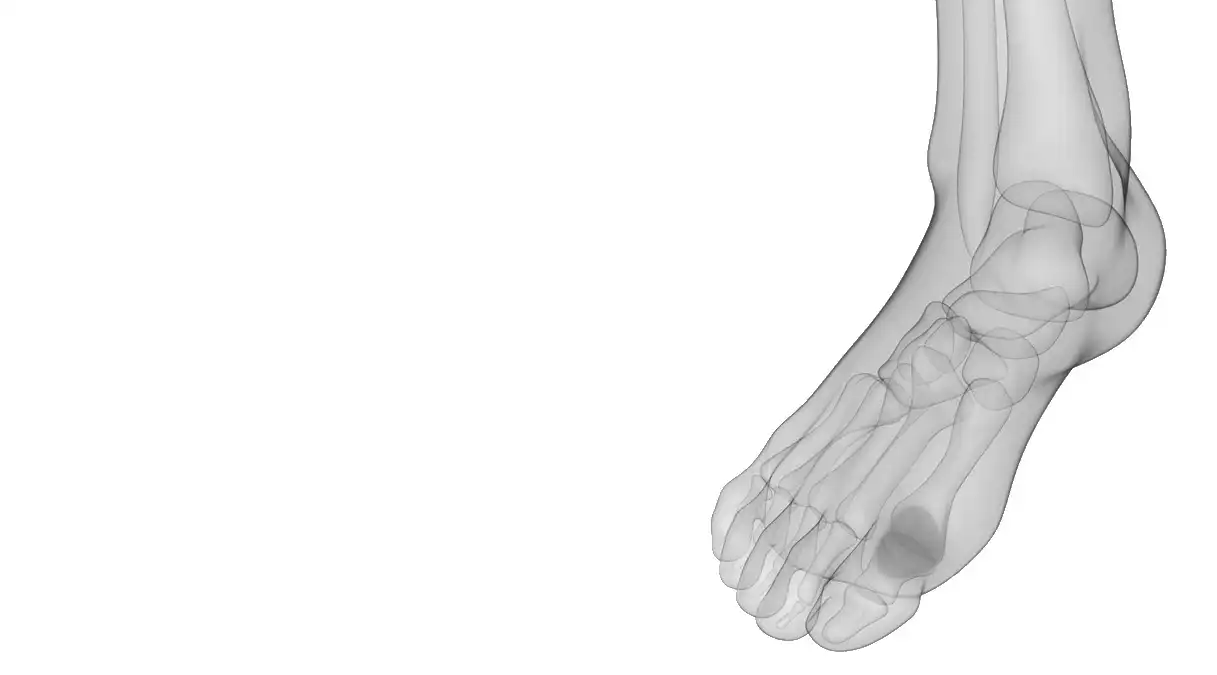Wearing high-heeled shoes induces multiple deformities in the sagittal plane and can be considered one of the most severe impairments to posture.
Introduction
The harmful effects of these shoes begin to manifest at the very base of the body, causing repercussions throughout the spine and beyond.
Regularly wearing high heels, often synonymous with elegance and self-confidence, nevertheless hides a series of harmful consequences for physical health. Beyond aesthetics, the impact of high heels extends from the lower body to the spine, sparking reflections on the relationship between fashion and health. In this article, we will explore the various symptoms, complications, and alternatives associated with frequent use of high heels, providing an informed perspective for those who wish to combine style and wellness.
Frequent use of high heels can cause excessive forward tilt of the pelvis, accentuating the lumbar curvature of the spine. This postural change can lead to muscle tension, imbalances and stress on joints, particularly in the knees, hips and lower back.
Additionally, the feet experience increased pressure, especially on the soles, which can contribute to the development of problems such as metatarsalgia, bunions and plantar fasciitis. High-heeled shoes can also encourage the formation of calluses and corns, thus affecting the health of the foot.
High-heeled shoes position the foot in plantar flexion, an unstable posture for the ankle and subtalar joints, which increases the risk of sprains. With heel elevation, more of the body’s weight is transferred to the front of the foot. The capacity of the transverse arch to handle this weight is exceeded, and the arch weakens and expands, causing the forefoot to widen. If the shoe is too narrow, the proximal phalanx of the big toe is pushed sideways, leading to a bunion (hallux valgus).
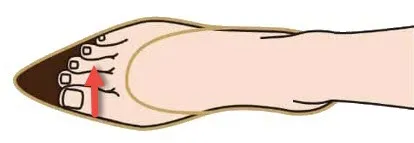
In osteopathy, hallux valgus is significant because it can lead to pain, inflammation, and altered gait mechanics, which may contribute to other musculoskeletal issues, such as knee, hip, or lower back pain.
Loss of the transverse arch of the foot is often associated with a decrease in both longitudinal arches of the foot, which increases the tensile forces placed on the plantar fascia. This increase in tension increases the risk of developing plantar fasciitis and a heel spur in the heel.

Due to the plantar flexion position imposed by high-heeled shoes, the plantar flexor muscles shorten and contract, while the dorsiflexor muscles lengthen and weaken. This situation frequently leads to spasms in the gastrocnemius and soleus muscles. Ironically, due to calf shortening (plantar flexion), women who wear high heels often experience pain when transitioning to flat shoes. The plantar flexors are so tight that they cannot stretch sufficiently when a person wears flat shoes. As a result, many of these people continue to prefer high-heeled shoes, mistakenly believing that they are more comfortable than flat shoes that cause immediate pain.
The solution often lies in a gradual transition from wearing high heels to low heels, then finally to flat shoes over a period of several months or even more than a year.
When wearing high-heeled shoes, the weight of the body is thrown forward, similar to standing on an inclined surface. To compensate, the trunk falls into flexion, increasing the anterior tilt of the pelvis and resulting in increased lordotic lumbar curvature. This posture can induce other secondary postural distortions, such as a swayback, rounded back, rounded shoulders, and forward head posture. These postural changes can cause headaches and possibly temporomandibular joint dysfunction. In sum, wearing high-heeled shoes is often associated with a range of foot and posture problems, highlighting the importance of awareness and careful transition to more health-promoting shoe choices. musculoskeletal.

right wearing high heels, which increases the pelvic tilt angle to 45 degrees. This adjustment in posture due to the elevated heel height causes a more pronounced lordosis (inward curve of the lower back), which can lead to additional stress on the lumbar spine and related musculoskeletal structures.
In osteopathic practice, such changes are significant when considering the long-term effects of wearing high heels on posture, spinal alignment, and potential lower back or hip pain. The increased pelvic tilt can shift the body’s center of gravity, causing compensatory adjustments in other areas, such as the knees and upper back.
A healthier way to compensate for high-heeled shoes is to bring your body weight back by tilting your pelvis backward. This helps prevent increased lumbar lordosis and all the unhealthy effects that result from it.
Consequences
- Accentuated Lumbar Lordosis: High heels can tilt the pelvis forward, accentuating the natural curvature of lumbar lordosis. This can lead to back pain and increased pressure on the lumbar spine.
- Stress on Intervertebral Discs: The altered position from high heels can increase pressure on the spinal discs, contributing to problems such as herniated discs.
- Accentuated Cervical Lordosis: High heels can also cause the head to tilt forward, accentuating the natural curvature of cervical lordosis. This can contribute to muscle tension in the neck and shoulders.
- Reduced Mobility: High heels limit mobility in the ankles and can lead to an altered gait, which can affect balance and increase the risk of falls.
- Muscle Contractions: Frequently wearing high heels can cause muscle contractures in the calves, thighs and back muscles due to the change in posture.
- Knee Pain: Increased pressure on the ball of the foot can contribute to knee pain, especially in people who regularly wear high heels.
- Ankle Instability: High heels can increase the risk of ankle injuries by altering the natural stability of the foot.
- Posture Issues: Wearing high heels can affect overall posture, leading to increased curvature in the lumbar and cervical regions and potentially contributing to poor posture.
- Chronic Lower Back Pain: Constant stress on the lumbar spine can lead to chronic lower back pain.
- Nerve Compression: Increased pressure on the spine from high heels can contribute to nerve compression, causing tingling or numbness sensations in the legs.
Postural Effects
Wearing high heels has a significant impact on posture, influencing various parts of the body including pelvic tilt, lumbar curvature and leading to postural distortions. Here is a more detailed explanation of these effects:
- Pelvic inclination:
- When you wear high heels, the body’s center of gravity shifts forward. To maintain balance, the pelvis tends to tilt forward.
- This tilt of the pelvis creates excessive curvature in the lumbar region of the spine, called lumbar lordosis. This can increase pressure on the lumbar vertebrae and intervertebral discs.
- Lumbar Curvature:
- High heels accentuate the natural curvature of the lumbar spine. Increased lumbar lordosis can lead to compression of the intervertebral discs and excessive strain on the lumbar muscles.
- This change in lumbar curvature can also affect overall posture by creating excessive curvature in the upper back to compensate for the forward tilt of the pelvis.
- Associated Postural Distortions:
- Prolonged wearing of high heels can cause long-term postural distortions. For example, the calf muscles may become shorter and tight, which can affect ankle flexibility.
- The knees may also undergo changes, with possible hyperextension due to the forward tilt of the body. This can increase the risk of knee injuries.
- Repercussions on other parts of the body:
- High heels can also influence shoulder posture by causing a slight backward tilt to compensate for the imbalance created by the forward tilt of the pelvis.
- The neck and upper back muscles can also become tight as the body adjusts to maintain balance and stability.
In summary, wearing high heels modifies posture by creating a forward tilt of the pelvis, accentuated lumbar lordosis, and compensatory adjustments in other parts of the body. These postural changes can cause discomfort, muscle tension and, in the long term, contribute to the development of orthopedic problems. It is therefore important to be aware of the effects of wearing high heels and take precautions to maintain a healthy posture.
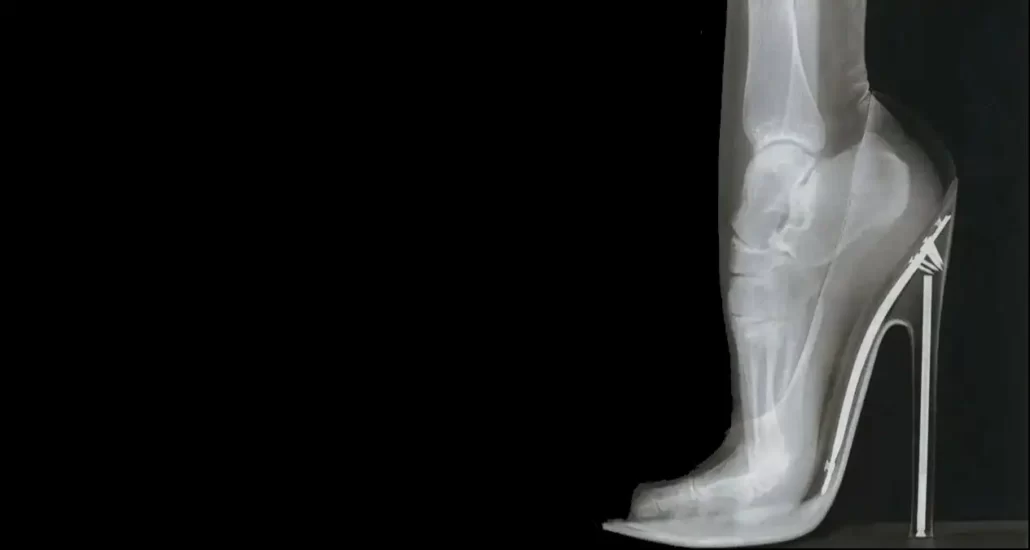
Biomechanical Changes and Potential Risks
High heels, while undeniably stylish, can wreak havoc on your body’s biomechanics, leading to a cascade of problems from the ground up. Understanding these changes and potential risks is crucial for making informed choices about your footwear.
The Domino Effect
The most significant biomechanical change caused by high heels is the altered position of the foot. Standing in heels elevates your heel, throwing your center of gravity forward. To compensate, your body makes a series of adjustments:
- Pelvic Tilt: The pelvis tilts forward excessively, increasing the curvature in your lower back (lumbar lordosis). This can strain the muscles and ligaments supporting your spine, potentially leading to pain and discomfort.
- Knee Strain: The forward tilt also puts extra stress on your knees. With each step, your knee joint has to work harder to maintain stability, increasing the risk of osteoarthritis over time.
- Tightened Calves and Achilles: To maintain balance, your calf muscles shorten and tighten. The Achilles tendon, which connects your calf muscles to your heel bone, also tightens and can become less flexible. This tightness can limit ankle movement and contribute to pain in the calves and Achilles tendon.
Foot Woes
The altered foot position in high heels also puts undue pressure on specific areas of your feet:
- Ball of the Foot: The weight-bearing surface shifts forward, concentrating pressure on the balls of your feet. This can lead to pain, callus formation, and metatarsalgia (pain in the ball of the foot).
- Cramped Toes: The pointed toe box of many high heels squeezes your toes together, forcing them into unnatural positions. This can cause bunions (hallux valgus), a bony bump that develops at the base of the big toe.
- Weakened Arches: High heels can contribute to a weakened arch. The constant pressure on the ball of the foot can stretch the plantar fascia ligament, which supports the arch. This can lead to pain, fallen arches, and flat feet.
Beyond the Feet
The biomechanical changes caused by high heels extend beyond your feet and legs. The altered posture can affect your entire body:
- Lower Back Pain: The increased lumbar lordosis can strain the muscles and ligaments in your lower back, leading to chronic pain.
- Reduced Core Strength: The forward tilt can weaken your core muscles, which are essential for maintaining good posture and stability.
- Hip Issues: High heels can also affect your hips. The altered gait pattern can put extra stress on your hip joints, potentially leading to pain and problems like bursitis.
Making informed footwear choices is vital for maintaining good biomechanics and overall health. By understanding the potential risks associated with high heels, you can make decisions that keep your body happy and moving freely.
Muscle Activation and Joint Loading
High heels may make you feel taller and more confident, but underneath the surface, they’re causing significant changes in how your muscles work and how much stress your joints experience. Understanding these changes can help you make informed decisions about your footwear.
Muscle Activation Shift
Walking in high heels activates your muscles differently compared to flat shoes. Here’s a breakdown:
- Increased Knee Extensor Activity: The muscles responsible for straightening your knee (knee extensors) become more active with high heels. This constant effort to maintain a straight leg can contribute to the development of knee osteoarthritis over time.
- Altered Foot Pressure Distribution: High heel wear significantly alters pressure distribution on your foot. As heel height increases, pressure concentrates more on the forefoot area, particularly the ball of the foot. This increased pressure can lead to pain and discomfort.
- Reduced Plantarflexion: Plantarflexion refers to the downward movement of your ankle joint, essential for pushing off during walking. High heels limit this movement, forcing your ankle into a more dorsiflexed (upward) position. This reduces the effectiveness of the push-off and can lead to gait abnormalities.
- Increased Back Muscle Activity: To maintain balance in the altered posture caused by high heels, your erector spinae muscles in the lower back become more active. This constant activation can lead to muscle fatigue and soreness.
Joint Overload
The altered muscle activation patterns caused by high heels put additional stress on various joints:
- Knee Strain: The increased activity of knee extensors creates excessive strain on the knee joint. This constant stress can accelerate wear and tear on the cartilage, potentially leading to osteoarthritis.
- Ankle Instability: The limitation of ankle movement due to reduced plantarflexion makes your ankles less stable. This increases the risk of sprains and other injuries.
- Spinal Stress: The additional activity of the erector spinae muscles to maintain posture puts undue stress on the vertebrae and discs in your spine. This can lead to pain, stiffness, and even misalignment.
Age Matters
The effect of high heels on muscle activation and joint loading can vary depending on your age:
- Younger Women: Younger women tend to experience increased erector spinae activity and a greater pelvic range of motion in the sagittal plane (forward-backward movement) while wearing high heels.
- Middle-Aged Women: Studies show significantly higher erector spinae activity and a posterior pelvic tilt (excessive backward tilt) with high heels in middle-aged women.
These age-related differences suggest that high heels may be even more detrimental to the musculoskeletal system of older women.
Long-Term Consequences
The constant changes in muscle activation and joint loading caused by high heels can lead to long-term consequences:
- Muscle Imbalances: The constant overuse of certain muscle groups (like back muscles) and underuse of others (like calf muscles) can lead to muscle imbalances, affecting posture and movement efficiency.
- Joint Degeneration: The increased stress on joints can accelerate the breakdown of cartilage, leading to osteoarthritis.
- Chronic Pain: Muscle imbalances and joint stress can contribute to chronic pain in the feet, knees, back, and hips.
Understanding how high heels alter muscle activation and joint loading is crucial for making informed footwear choices. Choosing shoes that promote proper alignment and balanced muscle engagement is essential for maintaining long-term musculoskeletal health.
Consequences on blood circulation
Frequently wearing high heels can have consequences on blood circulation, particularly in the legs and feet. Here are some points to consider regarding the impact on vascular health:
- Decreased venous return: High heels change the position of the foot, which can lead to decreased venous return. This means that blood has more difficulty flowing from the feet to the heart, which can lead to blood stagnation in the leg veins.
- Increased pressure on veins: High heels put more pressure on leg veins. This can contribute to the development of problems such as varicose veins, where veins become swollen and twisted due to excessive pressure.
- Risk of deep vein thrombosis (DVT): Impaired blood circulation combined with increased pressure on the veins can increase the risk of deep vein thrombosis. DVT occurs when blood clots form in deep veins, which can lead to serious complications if the clots break loose and travel to the lungs.
- Poor circulation in the feet: High heels can also compromise blood circulation to the feet. Poor circulation can lead to problems such as numbness, tingling, and reduced sensitivity.
- Stress on joints: In addition to circulatory problems, high heels can place increased stress on the joints of the legs, knees and back, which can affect mobility and overall health.
Psychological aspect
Here are some psychological aspects related to wearing high heels:
- Self-confidence: Many people report an increase in self-confidence when wearing high heels. The altered posture of heels can create a feeling of power and stature, which can contribute to greater self-confidence and a positive self-perception.
- Psychological effect of posture: High heels change posture by tilting the body forward, which can give the impression of a more graceful and elegant gait. This change in posture can also influence how a person is perceived by others, as well as how they perceive themselves.
- Expression of femininity: For some people, wearing high heels is associated with an expression of femininity and elegance. This can have a positive impact on emotional well-being and enhance feelings of femininity.
- Sense of Special Occasion: Wearing high heels is often associated with special occasions or formal events. In such situations, heels can play a role in creating a festive mood and contribute to a positive attitude.
- Psychological constraints: However, it is important to note that frequent wearing of high heels can also be a source of psychological constraints. Some people may experience discomfort, pain, or anxiety related to maintaining a certain appearance while wearing heels, which can interfere with psychological satisfaction.
- Beauty and gender norms: The use of high heels is sometimes linked to beauty and gender norms. This can create social pressures that influence self-perception and the need for conformity to pre-established aesthetic ideals.
In conclusion, the psychological impact of wearing high heels is complex and can vary from person to person. It can bring a feeling of self-confidence and elegance, but it can also generate psychological constraints. Understanding these psychological aspects contributes to a more comprehensive perspective on the overall influence of high heels on individual well-being.
Alternative path
For those who want to continue wearing high heels while minimizing health risks, here are some tips and alternatives:
- Moderate Height: Opt for moderate height heels rather than extremely high heels. Heels of 2 to 3 inches (about 5 to 7.5 cm) are generally considered more ergonomic and less stressful on the feet and legs.
- Arch support: Choose shoes with good arch support. This can help reduce pressure on the feet and improve comfort while wearing heels.
- Platform: Platform shoes can offer an alternative to high heels by better distributing pressure across the foot. Platforms reduce foot tilt, which may be more comfortable for some people.
- Soft materials: Opt for shoes made from soft, quality materials. Shoes that conform to the natural shape of the foot can reduce discomfort and minimize pressure on the joints.
- Alternate with flat shoes: Don’t wear high heels all the time. Alternate with flat shoes to allow your feet and legs to rest and recover.
- Stretches and exercises: Practice regular stretches for your feet, ankles and calves. This can help prevent muscle stiffness and improve flexibility.
- Respect your limits: If you feel pain or discomfort, don’t hesitate to remove your heels. Don’t force your feet to adapt to shoes that aren’t comfortable.
- Select Appropriate Occasions: Reserve wearing high heels for special occasions rather than everyday use. This helps reduce constant pressure on the feet and legs.
- Consult a professional: If you are experiencing health concerns related to wearing high heels, consult a podiatrist or healthcare professional who specializes in feet. They can provide personalized advice and solutions tailored to your needs.
Finding a balance between style and comfort is essential to minimize the risks associated with wearing high heels. By following these tips and exercising caution, you can continue to enjoy your heels while maintaining the health of your feet and legs.
Recommendation to stop wearing high heels
- Gradual transition: If you have regularly worn high heels, consider a gradual transition to shoes with lower heels. This allows your feet and muscles to gradually adjust.
- Choose comfortable shoes: Opt for flat shoes or shoes with low heels that provide good support and don’t put too much pressure on your feet.
- Stretches and exercises: Practice stretches and exercises to strengthen the muscles in your feet, ankles, and calves. This can help reduce built-up tension.
- Foot Massage: Give your feet regular massages to relieve tension and improve blood circulation.
- Use of insoles: If necessary, consider the use of comfortable insoles for additional support.
- Consult a healthcare professional: If you experience persistent pain or foot problems, consult a podiatrist or healthcare professional for a thorough examination.
- Examine your posture: Work on your posture by standing up straight and balancing weight equally on both feet. Posture plays a crucial role in reducing tension.
- Prefer shoes with a wide toe: Opt for shoes with a wide toe to allow the toes to extend naturally.
- Hydration and foot care: Take care of your feet by moisturizing them regularly and inspecting them for possible skin problems.
- Patience and self-observation: Be patient and observe how your feet and body respond to change. If necessary, adjust your routine accordingly.
Stretches and exercises
If you’ve stopped wearing high heels and want to strengthen your feet, ankles and calves while improving your flexibility, here are some recommended stretches and exercises:
Foot and Ankle Stretches
- Calf stretch against the wall:
- Stand facing a wall.
- Stretch one leg behind you and keep your heel on the floor.
- Lean forward slightly to feel the calf stretch.
- Hold the position for 15 to 30 seconds and repeat on the other side.
- Ankle rotation:
- Sitting or standing, lift one leg and rotate clockwise, then counterclockwise.
- Repeat with the other leg.
- Stretching the top of the foot:
- Get on your knees.
- Place the top of the foot on the floor with the toes bent backwards.
- Sit back on your heels to stretch the top of your foot.
- Hold the position for 15 to 30 seconds.
Exercises to Strengthen Feet and Ankles
- Calf raises:
- Stand with feet shoulder-width apart.
- Slowly lift your heels off the floor while standing on your tiptoes.
- Gently lower your heels.
- Repeat 15 to 20 times.
- Toe flexions:
- Sitting, stretch your legs in front of you.
- Flex your toes toward you as far as possible.
- Hold the position for 10 to 15 seconds and release.
- Repeat several times.
- Towel pickup with toes:
- Place a towel on the floor.
- Use toes to pick up the towel and pull it towards you.
- Repeat several times.
Calf Stretches:
- Seated Calf Stretch:
- Sit with your legs straight.
- Bend one leg and place the sole of your foot against the thigh of the other leg.
- Lean forward slightly to feel the calf stretch.
- Hold the position for 15 to 30 seconds and repeat on the other side.
- Standing Calf Stretch:
- Standing, place one foot back with the heel on the floor.
- Slightly bend the knee of the back leg.
- Lean forward to feel the calf stretch.
- Hold the position for 15 to 30 seconds and repeat on the other side.
These stretches and exercises can help strengthen muscles, improve flexibility, and reduce tension after you stop wearing high heels. It is important to do them regularly and gradually, listening to your body.
Conclusion
In short, the seduction of high heels should not ignore the potential consequences on health. Postural imbalances, muscular tensions, and the risk of sprains are realities that it is important to face. However, the transition to more ergonomic footwear and more mindful practices offers an alternative path for those who crave a compromise between style and comfort. Prioritizing musculoskeletal health while maintaining a sought-after aesthetic is a balance to achieve, thus highlighting the importance of a considered approach in the choice of our shoes.
References
- Cronin, N. J., & Barrett, R. S. (2004). The effect of high-heeled shoes on ankle joint biomechanics during walking. Journal of Applied Biomechanics, 20(3), 282-292.
- This study analyzes how wearing high-heeled shoes affects ankle joint biomechanics during walking, increasing the risk of injury.
- Opila-Correia, K. A. (1990). Kinematics of high-heeled gait with consideration for age and experience of wearers. Archives of Physical Medicine and Rehabilitation, 71(11), 905-909.
- This article explores the influence of age and experience on walking in high heels and how this can lead to postural changes and imbalances.
- Esenyel, M., Walsh, K., Walden, J. G., & Gitter, A. (2003). Kinetics of high-heeled gait. Journal of the American Podiatric Medical Association, 93(1), 27-32.
- This research focuses on the forces exerted on the feet and joints while walking in high heels, highlighting the risks of pain and soft tissue injuries.
- Kerrigan, D. C., Todd, M. K., & Riley, P. O. (1998). Knee osteoarthritis and high-heeled shoes. The Lancet, 351(9113), 1399-1401.
- This article highlights the impact of wearing high heels on the development of knee osteoarthritis due to increased joint forces.
- De Oliveira Pezzan, P. A., João, S. M. A., Ribeiro, A. P., & Pires de Camargo Neves Sacco, I. (2011). Postural assessment of lumbar curvature and pelvic inclination angle in adolescents with different weights of school backpacks. The Spine Journal, 11(10), 895-901.
- Although this study focuses on adolescents, it addresses similar effects on lumbar curvature and pelvic tilt that can be compared to the effects of wearing high heels.





